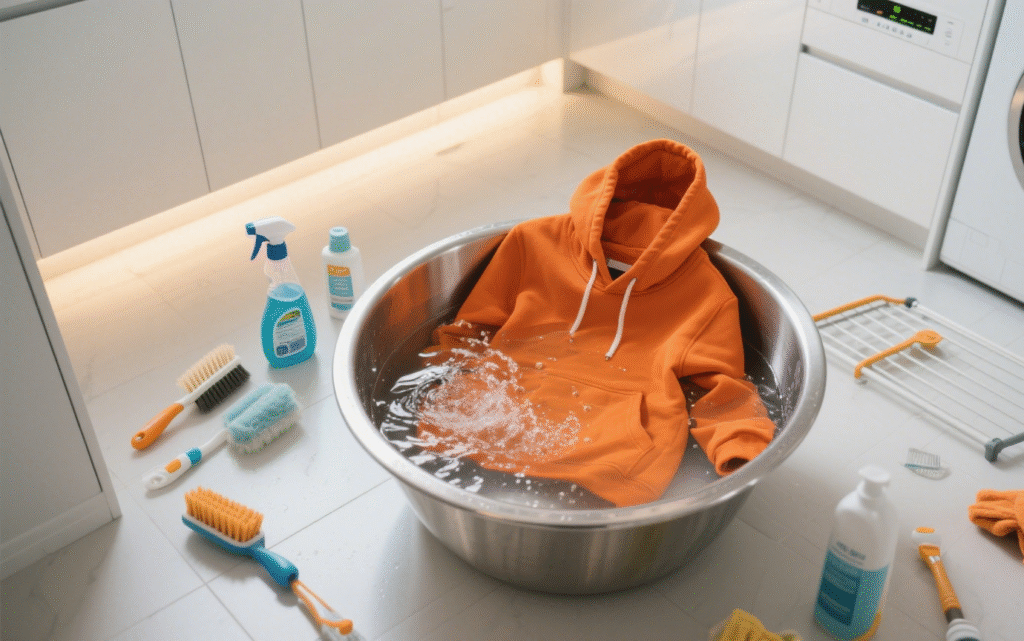There’s no better feeling than pulling on a brand-new, incredibly soft hoodie. It’s like a warm hug you can wear. But after a few washes, that plush, cozy magic often fades, leaving you with a stiff, scratchy garment. What happened?
The good news is, it doesn’t have to be this way. Keeping your hoodie soft isn’t about expensive products or complicated tricks. It’s about understanding what makes fabric stiff and learning the right way to wash and dry it. Whether it’s your favorite fleece hoodie or a lightweight cotton blend, these tips will help preserve the fabric’s feel, wash after wash.
Ready to restore that cloud-like softness to your favorite hoodie for good? Let’s dive in.
Why Soft Hoodies Matter More Than You Think?
Picture this: you roll out of bed, excited to throw on your favorite hoodie, only to realize it’s scratchy and stiff. Suddenly, that cozy morning vibe is gone, replaced by annoyance. It’s like starting your day on a rocky road, and nothing seems to click right.
But oh, when you slip into a hoodie that’s as soft as a cloud? Game. Changer. It’s like wrapping yourself in a warm, fuzzy hug from an old friend. Every time I wear my super-soft hoodie, I feel this instant wave of relaxation wash over me. It’s as if all my stress melts away with each gentle touch against my skin. Whether I’m curled up on the couch binge-watching my favorite show or running errands around town, that soft fabric makes everything better.

Choose the Right Fabric for Maximum Softness
Not all fabrics are created equal when it comes to softness. To ensure your hoodie stays plush and comfortable, start by choosing the right material:
- Cotton: Pure cotton hoodies are known for their softness, making them ideal for those who prioritize comfort. Look for hoodies made from 100% organic cotton for even softer, eco-friendly options.
- Polyester Blends: Many hoodies are made from polyester-cotton blends, offering a balance of durability and comfort. These blends typically stay softer longer, even after multiple washes.
- Bamboo and Hemp Blends: These fabrics are naturally soft and hypoallergenic, providing an extra touch of comfort. Though they can be a little more expensive, they’re worth considering if you want an eco-conscious, soft hoodie.
- Fleece & Terrycloth: Fleece-lined and terrycloth hoodies are soft, but they require special attention when laundering to maintain that softness. Fleece can pill over time if exposed to rough washing conditions.
Learn more about the hoodie: such as manufacturing process, weight, fabric, shrinkage treatment process, pattern printing process, etc. It can better help you choose the softest hoodie.
When shopping for a new hoodie, don’t be shy—touch and feel the fabric! Run your fingers over it to check for any roughness or stiffness. Flip it inside out to examine the inner lining, especially if it’s fleece-lined. And don’t forget to read the label carefully. Look for high-quality materials and avoid fabrics with a lot of synthetic additives that might feel scratchy.

Why Hoodies Lose Their Softness?
Before we dive into how to keep your hoodie soft, it’s helpful to understand why it loses its softness in the first place.
Common Causes of Rough Hoodies
- Washing Damage: Frequent washing breaks down fabric fibers, causing them to lose their soft texture. The abrasion of the washing machine’s drum and contact with other clothes speeds up this process.
- Fabric Breakdown: Fabrics like cotton and polyester can degrade over time, especially with frequent washing and wearing.
- Environmental Factors: Exposure to sunlight, harsh weather, or improper storage can cause the fabric to lose its plush feel.
- Harsh Detergents and Additives: Many detergents contain chemicals that strip away natural oils from fabrics, leading to stiffer fibers. Fabric softeners, while initially adding softness, can build up over time and make fabrics feel heavy or sticky.
- Heat Exposure: Hot water and high-heat drying are two culprits that can degrade fabric softness. Heat can damage fibers and cause them to shrink or become rough. Even if the fabric doesn’t shrink, repeated exposure to high temperatures can lead to long-term wear.
- General Wear and Tear: Hoodies aren’t invincible. Daily use, friction, and time naturally reduce softness, especially for items like fluffy hoodies or inside-out fleece sweatshirts.
Why Fabric Care Matters?
Let me tell you a little secret: hoodies aren’t all made equal. The fabric—whether it’s cotton, polyester blends, or fleece—determines how it should be cared for. It’s easy to forget about those washing instructions tucked away on the label, but overlooking them can quickly turn your favorite hoodie into a rough, worn-out mess.
Think of your hoodie’s fabric as a unique fingerprint; each one has its own set of needs. For instance, cotton hoodies are breathable and soft, but they can shrink and fade if washed in hot water or dried on high heat. Polyester blends, on the other hand, are more durable and resistant to wrinkles, but they can trap odors if not washed properly. Fleece hoodies are super warm and fuzzy, but they tend to pill if rubbed against rough surfaces or washed with abrasive materials.
That’s why understanding your hoodie’s material is the first and most important step in learning how to keep it soft, comfortable, and looking great for years to come. And when it comes to high-quality hoodies that are built to last, Sumkclothing really stands out from the crowd. Their hoodies are crafted with the utmost care and attention to detail, using only the finest materials and the latest manufacturing techniques. But even the best hoodies in the world need a little tender loving care to stay in top condition.

Preparing to Restore Your Hoodie’s Softness
Step 1: Assess the Damage
Before jumping into restoration, take a moment to assess your hoodie’s current state. How’s your hoodie looking?
- Feel the Fabric: Gently run your hands over the fabric. Is it stiff like cardboard, or just has a subtle roughness? Understanding the severity of the stiffness helps tailor your treatment.
- Look for Pilling: Those tiny fiber balls (called “pilling”) are more than just an eyesore—they’re a signal your hoodie needs care. Instead, note how widespread the pilling is—light patches or full-on fuzzy zones? This helps determine if you’ll need a de-pilling tool later.
- Separate by Material: If you’re working on multiple hoodies, group them by fabric type!Different fabrics respond differently to treatments.Cotton loves gentle detergents, while synthetic blends might need extra care to avoid losing their stretch.
Step 2: Gather the Right Tools
Gather these essentials to turn your crunchy hoodie into a snuggly cloud:
Detergent Options
- Gentle Commercial Detergent: Look for labels like “hypoallergenic” or “for delicate fabrics”
- Natural Alternatives: For eco-warriors or sensitive skin folks, mix ½ cup white vinegar (to break down residue) and ¼ cup baking soda (to soften fibers) into your wash cycle.
Water Temperature Control
- Cold water is your BFF here! Hot water damages fibers, causing more stiffness and shrinkage. Set your washer to the coldest setting—your hoodie will thank you with softer stitches.
Optional Tools for Extra Love
- Soft Bristle Brush: Perfect for gently brushing out surface pilling (use short, upward strokes on fleece linings).
- De-Pilling Comb/Shaver: If pilling is heavy, these tools safely remove those fuzzy balls without harming the fabric.
If you are at school and don’t have the right tools around, here are some extra tips to keep your hoodie clean and soft.

Step-by-Step Guide: How to Make Hoodies Soft Again
Now that you’re ready, let’s get down to business.
Step 1: Pre-Treat Stains (If Needed)
Soak your hoodie in a vinegar and water solution before washing it. Mix one cup of white vinegar with a gallon of warm water and soak your hoodie for 30 minutes. Vinegar helps break down any detergent or fabric softener residue, which can make the fabric stiff.
Step 2: Turn It Inside Out
This protects the outer fabric from friction against other clothes and the washing machine drum, reducing pilling and wear. It also keeps the inner lining (especially fleece) from matting down.
Step 3: Use Cold Water
Hot water can shrink cotton, damage elastic fibers, and cause dyes to bleed. Set your washer to the cold or lukewarm setting—cold water is gentler on fabrics and helps preserve softness.
Step 4: Choose the Gentle Cycle
Select a delicate or gentle wash cycle to minimize agitation. High-speed cycles can twist and stress fibers, leading to stiffness. If hand-washing is an option (for delicate fabrics or vintage hoodies), fill a basin with cold water, add detergent, and gently press the hoodie into the water—never wring or twist it.
Step 5: Use the Right Detergent Amount
Overloading detergent leaves residue on fabric, which makes it feel crunchy. Follow the dosage instructions on your detergent bottle—usually 1–2 tablespoons for a regular load. For natural alternatives:
- White vinegar: Add ½ cup of distilled white vinegar during the rinse cycle. It softens fibers, removes detergent buildup, and neutralizes odors without leaving a scent.
- Baking soda: Add ¼ cup of baking soda to the wash drum along with detergent. It softens water and boosts cleaning power gently.

Drying Techniques to Retain Hoodie Softness
How you dry your hoodie can make a big difference in maintaining its softness. Here are a few expert-approved techniques:
- Air Dry When Possible: The gentlest way to dry your hoodie is by laying it flat or hanging it to air dry. This prevents heat damage, which can make the fabric lose its soft texture.
- Tumble Dry on Low Heat: If you need to use a dryer, always choose a low heat setting. High heat can shrink the fabric and make it feel rougher over time. Drying on a low setting will help maintain the hoodie’s softness without compromising its size or feel.
- Avoid Direct Sun Exposure: While sunlight can help dry your hoodie, it can also cause the fabric to fade and stiffen. Dry your hoodie in a shaded area or indoors to preserve its softness and color.
The best option is to air dry instead of using a dryer.
Why Air Drying is Better: Tumble drying can cause fabrics to shrink, lose their softness, and even wear out faster due to the high heat and constant friction. Instead, air drying your hoodie preserves its softness and helps maintain its original shape. Lay your hoodie flat on a drying rack or hang it in a well-ventilated area to dry naturally.
Tips for keeping your hoodie soft: How to store it properly
The correct way to store your hoodie is very important. It can effectively prolong the softness of your hoodie:
- Avoid Humidity: Humidity can break down fabrics and lead to musty odors. Always store your hoodies in a cool, dry place. A closet with good airflow is ideal to keep your hoodies fresh and soft.
- Use Fabric Storage Bags: If you need to store your hoodie for a long time, consider using breathable fabric storage bags. These help protect against dust and environmental damage while keeping the fabric soft.
Fold, Don’t Hang
While it might seem natural to hang your hoodie in the closet, folding your hoodie is the better option. Hanging it can stretch out the fabric, especially around the shoulders. Instead, fold it neatly and place it in a drawer or on a shelf. Professional Tips for How to Fold Hoodies. It can help you fold hoodies more efficiently and keep them soft.
Store in a Cool, Dry Place
Make sure your hoodies are stored in a cool, dry location. Humidity can cause fabric to become stiff, while heat can break down fibers over time. A cool, dry place also keeps the fabric fresher for longer.
Avoid Overcrowding in the Closet
Don’t overcrowd your closet with too many hoodies. Overpacking can cause unnecessary wrinkles and stretching, which will ultimately affect softness. Leave enough space for the fabric to breathe.

Common Mistakes to Avoid When Caring for Your Hoodie
While there are plenty of things you can do to keep your hoodie soft, there are also some common mistakes that you should avoid:
- Over-Washing: Washing your hoodie too often can break down the fibers and make the fabric rough. Wash it only when necessary to preserve its softness.
- Using High Heat: High temperatures can cause the fabric to shrink and lose its softness. Always opt for cold water and low heat when washing and drying.
- Storing Hoodies Wet: Never store your hoodie while it’s still damp. This can cause the fibers to stiffen and even lead to unpleasant odors. Make sure your hoodie is completely dry before folding or hanging it.
For more expertise on hoodies, please contact sumkclothing. They are the leading hoodies manufacturer with rich experience. They can help you solve any problems of hoodies.
Frequently Asked Questions (FAQ)
To keep your hoodie soft, wash it with cold water using a gentle detergent. Avoid using fabric softeners as they can build up and make fabric feel stiff. Air dry your hoodie or tumble dry on low heat to maintain its softness.
Hoodies lose their softness over time due to factors like washing in hot water, using fabric softeners, and drying at high heat. These actions can break down the fabric fibers, causing them to stiffen or become rough.
If your hoodie feels stiff, it’s likely due to harsh washing or drying methods. Hot water, high heat drying, and overuse of fabric softeners can strip the natural softness of the material and make it feel rigid.
While fabric softener can temporarily soften your hoodie, over time it can lead to buildup that reduces softness and affects the fabric’s absorbency. For long-term softness, try using alternative natural methods like vinegar or baking soda during the wash.
To protect your hoodie from sun fading, turn it inside out before washing, and air dry it in the shade. Avoid prolonged exposure to direct sunlight, especially during peak hours. You can also use a UV fabric spray to help shield it from the sun’s harmful rays.
Washing your hoodie after every 3–4 wears is generally sufficient unless it gets visibly dirty. Frequent washing can wear down the fabric and reduce its softness, so spot cleaning or airing it out in between washes is a good option.
FAQ
Yes, drying on high heat can damage hoodie fabric by causing it to shrink and lose softness. High heat can break down the fibers, making your hoodie feel rough. Always dry your hoodie on low heat or air dry it to preserve its softness.
To keep the inside of your hoodie soft, make sure you wash it gently with cold water and use a mild detergent. Avoid drying on high heat, and flip the hoodie inside out before washing to minimize wear and tear on the soft interior.
The easiest way to make your hoodie soft again is by washing it with cold water and skipping the fabric softener. Instead, add a cup of white vinegar to the rinse cycle to naturally soften the fabric.
The best way to dry a hoodie is by air drying it on a flat surface or hanging it up. If you use a dryer, set it to low heat. High heat can damage the fibers, making the hoodie feel rough and stiff.
To restore softness to a hoodie, wash it with cold water and use a gentle detergent. Consider adding half a cup of white vinegar to the rinse cycle to help soften the fabric naturally. Avoid using fabric softeners or hot water, which can cause stiffness.




